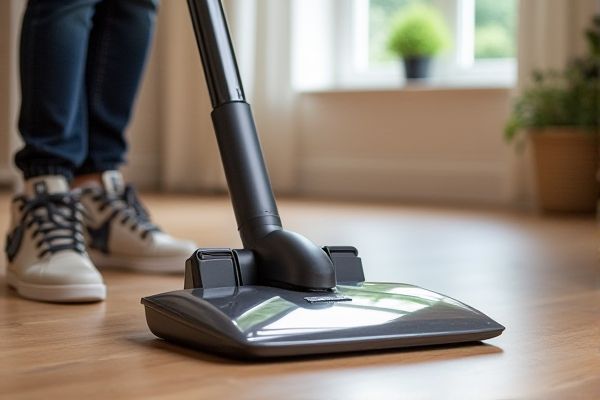
A central vacuum port offers superior cleaning convenience and efficiency by allowing you to quickly connect a hose and clean multiple rooms without lugging a heavy broom or vacuum around, while traditional brooms require manual sweeping that can leave behind dust and allergens. Discover how upgrading to a central vacuum port can transform Your home cleaning routine by reading the rest of the article.
Table of Comparison
| Feature | Central Vacuum Port | Traditional Broom |
|---|---|---|
| Cleaning Efficiency | High suction power removes fine dust and debris effectively | Effective for surface dirt but misses fine dust and allergens |
| Health Impact | Reduces airborne dust and allergens, improving indoor air quality | Stirs up dust particles, potentially increasing allergies |
| Convenience | Built-in wall ports allow easy connection of hose without carrying equipment | Portable and simple but requires manual effort and storage space |
| Noise Level | Quieter operation as motor is located remotely | Silent operation |
| Maintenance | Requires periodic filter and bag replacement | Minimal maintenance; occasional cleaning of bristles |
| Cost | Higher initial installation and system cost | Low upfront cost |
| Durability | Long-lasting with professional installation | Wear and tear on bristles over time |
| Ideal Usage | Best for large homes and allergy sufferers | Suitable for small cleanups and quick dirt removal |
Introduction to Central Vacuum Ports and Traditional Brooms
Central vacuum ports offer a built-in cleaning solution integrated into a building's infrastructure, providing powerful suction and convenience by eliminating the need to carry heavy equipment. Traditional brooms remain a simple, manual tool ideal for quick surface debris removal with no reliance on electricity or installation. Central vacuum systems enhance indoor air quality by venting dust outside, whereas brooms often stir up particles, potentially affecting sensitive respiratory conditions.
How Central Vacuum Ports Work
Central vacuum ports function by connecting a network of in-wall tubing to a powerful vacuum unit, typically installed in a utility area, allowing debris to be sucked directly from the port through the piping system. Unlike traditional brooms that merely sweep and disperse dust, central vacuum systems efficiently remove dirt and allergens from floors and carpets without reintroducing dust into the air. This method enhances indoor air quality and reduces the effort needed for thorough cleaning compared to conventional sweeping tools.
Traditional Brooms: Simplicity and Accessibility
Traditional brooms offer simplicity and accessibility with their lightweight design and ease of use, requiring no electricity or maintenance. Their straightforward functionality makes them ideal for quick cleanups on various surfaces, particularly in areas without power sources. However, traditional brooms often struggle with fine dust and allergens compared to the efficient suction of central vacuum ports.
Cleaning Efficiency: Central Vacuum vs. Broom
Central vacuum systems offer superior cleaning efficiency compared to traditional brooms by effectively removing fine dust, allergens, and debris from carpets, hardwood floors, and hard-to-reach areas. These systems use powerful suction and advanced filtration technology, significantly reducing airborne particles and providing a deeper clean. In contrast, traditional brooms often redistribute dust and struggle with fine particles, limiting their ability to maintain a truly clean indoor environment.
Health and Allergy Considerations
Central vacuum ports significantly reduce airborne dust and allergens by directly channeling dirt outside your living space, enhancing indoor air quality and benefiting allergy sufferers. Traditional brooms often disperse dust and allergens into the air during sweeping, which can aggravate respiratory issues. Choosing a central vacuum system helps maintain a cleaner, healthier environment by minimizing exposure to irritants.
Time and Labor Comparison
Central vacuum ports significantly reduce cleaning time by providing consistent suction power without the need to manually sweep debris into a dustpan, streamlining the labor process. Traditional brooms require repeated physical effort to gather and collect dirt, increasing time spent on each cleaning session. The automation and efficiency of central vacuum systems lower overall labor intensity and enable faster, more thorough cleaning compared to traditional broom methods.
Maintenance and Longevity
Central vacuum ports require minimal maintenance due to their built-in filtration systems, reducing the need for frequent dust disposal compared to traditional brooms. Traditional brooms wear out faster as bristles degrade with regular use and need replacement more often. The longevity of central vacuum systems often surpasses brooms, offering a durable and efficient cleaning solution with less upkeep over time.
Environmental Impact and Energy Use
Central vacuum systems significantly reduce indoor air pollution by effectively capturing dust and allergens at the source, unlike traditional brooms that often disperse particles into the air. These systems consume less energy over time due to their efficient motors and centralized design, leading to lower electricity usage compared to the manual labor and frequent replacement of traditional broom components. The environmental benefits include reduced waste from disposable broom fibers and decreased greenhouse gas emissions associated with electricity consumption in central vacuum models optimized for energy efficiency.
Cost Analysis: Installation and Upkeep
Central vacuum ports typically require a higher initial investment for installation, ranging from $1,000 to $3,000, compared to the low upfront cost of a traditional broom. However, maintenance costs for a central vacuum system tend to be lower over time, as filters and bags require infrequent replacement, while traditional brooms need regular replacement due to wear and tear. Your long-term cost savings may be significant with a central vacuum system, especially in larger homes or commercial spaces where efficiency and durability are prioritized.
Conclusion: Choosing the Right Cleaning Solution
Central vacuum ports offer superior dust removal and improved indoor air quality compared to traditional brooms, making them ideal for allergen-sensitive households. Traditional brooms provide quick, cost-effective cleaning for small messes but often disperse dust particles into the air. Selecting the right cleaning solution depends on balancing efficiency, health benefits, and budget considerations for specific household needs.
 homyna.com
homyna.com